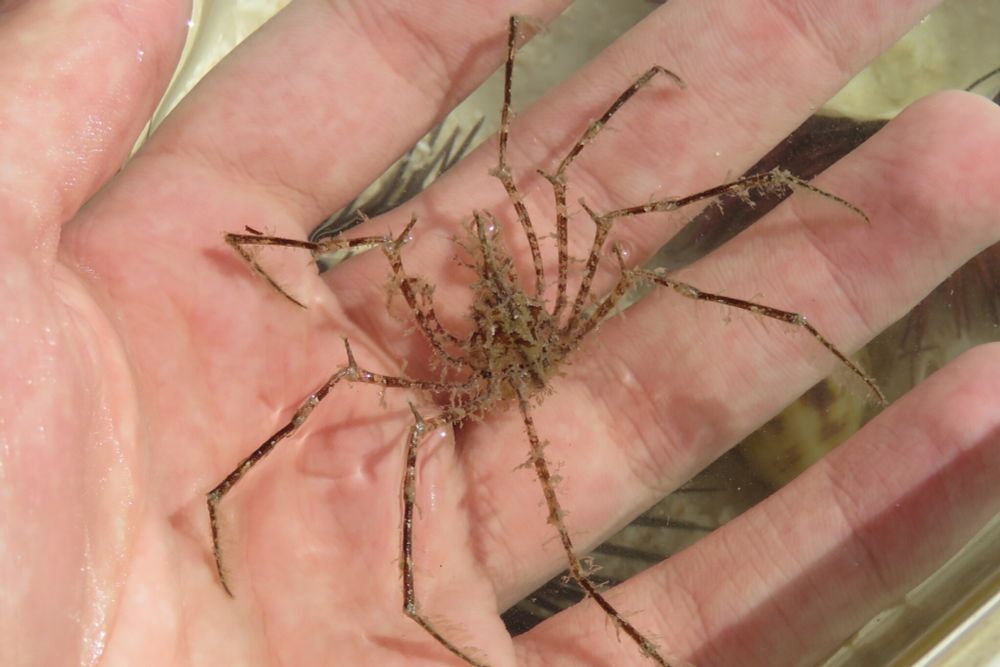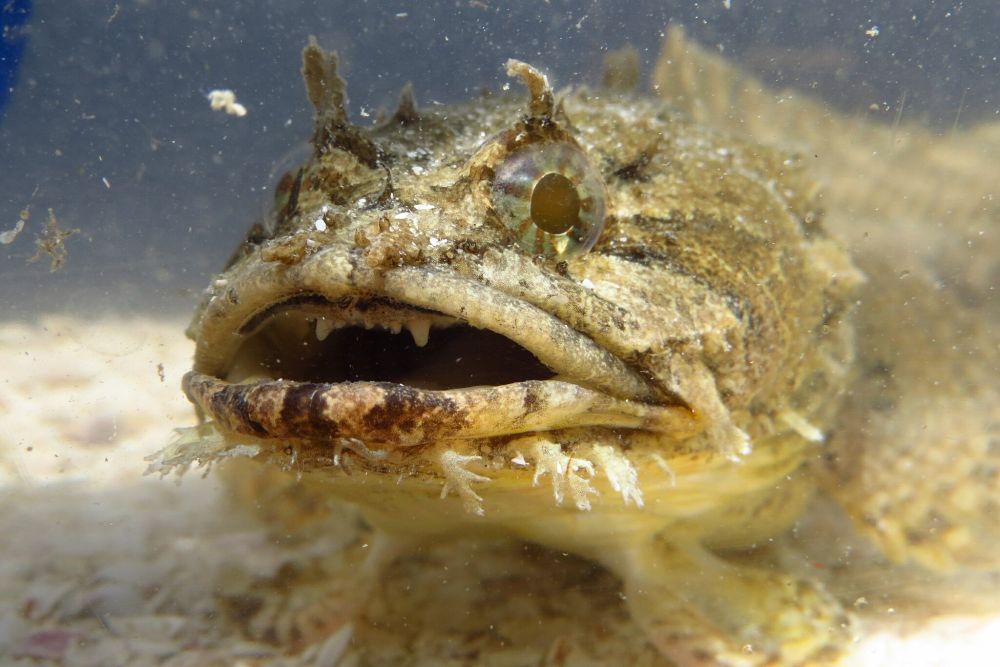
Ichthyologist soon-to-be, hopefully.
Activity not guaranteed. We'll see what the tide brings in, aye?
Dwarf seahorses are truly tiny, with adults only reaching a meagre 2 inches.
Meanwhile, lined seahorses are monsters in comparison. Occasionally reaching a mighty 7in, they will consume anything small enough to fit into their mouths- this includes small fish.
#25DaysofFishmas


Dwarf seahorses are truly tiny, with adults only reaching a meagre 2 inches.
Meanwhile, lined seahorses are monsters in comparison. Occasionally reaching a mighty 7in, they will consume anything small enough to fit into their mouths- this includes small fish.
#25DaysofFishmas
Pink shrimp can attain respectable sizes, with large individuals measuring up to about 10 inches long. Speaking from experience, they grow fast!
The flat bodies of green porcelain crabs allow them to hide in very narrow spaces. They're quite secretive.




Pink shrimp can attain respectable sizes, with large individuals measuring up to about 10 inches long. Speaking from experience, they grow fast!
The flat bodies of green porcelain crabs allow them to hide in very narrow spaces. They're quite secretive.
It is a tough species, capable of surviving temperature extremes and oxygen-depleted water. As long as there is enough small prey (it is not choosy) and enough plants to hide in, it is happy.
#25DaysofFishmas

It is a tough species, capable of surviving temperature extremes and oxygen-depleted water. As long as there is enough small prey (it is not choosy) and enough plants to hide in, it is happy.
#25DaysofFishmas
This is a wonderfully rectangular, flat isopod that likes the sandy, shelly substrates of nearshore marine habitats, particularly beaches.
When threatened, it rolls into a ball. It's flat, broad shape means it can only try it's best.


This is a wonderfully rectangular, flat isopod that likes the sandy, shelly substrates of nearshore marine habitats, particularly beaches.
When threatened, it rolls into a ball. It's flat, broad shape means it can only try it's best.
The venom sequestered within each fin spine is potent, and causes a laundry list of nasty symptoms, not to mention severe pain. The 'cool' factor is undeniable.
#25DaysofFishmas


The venom sequestered within each fin spine is potent, and causes a laundry list of nasty symptoms, not to mention severe pain. The 'cool' factor is undeniable.
#25DaysofFishmas
Additionally, this species was described recently, only two years ago. I think they're really, really cute...

Additionally, this species was described recently, only two years ago. I think they're really, really cute...
The spotted sunfish is an endemic to the southeastern United States, primarily Florida. These individuals live inside of a flooded sinkhole, where they are one of the only few species of fish present.
#25DaysofFishmas




The spotted sunfish is an endemic to the southeastern United States, primarily Florida. These individuals live inside of a flooded sinkhole, where they are one of the only few species of fish present.
#25DaysofFishmas
This species lives in seagrass beds, oyster reefs, and in sponges unlike many species in the genus. Their vivid color and way of moving, swaying back and forth, make them popular in aquariums.


This species lives in seagrass beds, oyster reefs, and in sponges unlike many species in the genus. Their vivid color and way of moving, swaying back and forth, make them popular in aquariums.
Named for their prominent blue spots on the inner surface of their arms, their eyes and antennae also take on a bluish hue. The feathery antennae catch small pieces of floating food.



Named for their prominent blue spots on the inner surface of their arms, their eyes and antennae also take on a bluish hue. The feathery antennae catch small pieces of floating food.
Of gulf Florida's puffers, the bandtail is amongst the smallest. Small extensions on the skin are effective aids in camouflage, and the row of black spots along the lower flank as well as the reflective eyes are especially beautiful.
#25DaysofFishmas



Of gulf Florida's puffers, the bandtail is amongst the smallest. Small extensions on the skin are effective aids in camouflage, and the row of black spots along the lower flank as well as the reflective eyes are especially beautiful.
#25DaysofFishmas
The odd little 'fingers' under the head are modified fin rays, and are used to walk and feel around in soft substrates for buried prey. They are covered in taste buds and are very sensitive.
#25DaysofFishmas


The odd little 'fingers' under the head are modified fin rays, and are used to walk and feel around in soft substrates for buried prey. They are covered in taste buds and are very sensitive.
#25DaysofFishmas
Young stone crabs are tiny and purple, more like a smooth pebble than a stone. Adults, meanwhile, are heavily-armed, brown, and comparatively rugged.


Young stone crabs are tiny and purple, more like a smooth pebble than a stone. Adults, meanwhile, are heavily-armed, brown, and comparatively rugged.
Ballyhoo are a species of halfbeak, a group of flyingfish and needlefish relatives. Many exhibit an extremely long, disproportionate lower jaw- as for the ballyhoo, it gets much, much longer with age. These fish are accomplished jumpers.

Ballyhoo are a species of halfbeak, a group of flyingfish and needlefish relatives. Many exhibit an extremely long, disproportionate lower jaw- as for the ballyhoo, it gets much, much longer with age. These fish are accomplished jumpers.
The thick coat of hair that covers it's body conceals the stout, sharp thorns that cover almost the entirety of it's surface. These crabs love living in sponges, and are difficult to extract.


The thick coat of hair that covers it's body conceals the stout, sharp thorns that cover almost the entirety of it's surface. These crabs love living in sponges, and are difficult to extract.
Juveniles, unlike many hakes and cod-likes, grow in nearshore mangrove and seagrass bed habitats before migrating offshore, sometimes to depths of 400 meters.
#25DaysofFishmas


Juveniles, unlike many hakes and cod-likes, grow in nearshore mangrove and seagrass bed habitats before migrating offshore, sometimes to depths of 400 meters.
#25DaysofFishmas
This species can be distinguished from the larger and often bluer Atlantic blue crab by it's smaller size, matte plastic-like carapace, and tendency towards a bone white coloration. It's aggressive demeanor is much like it's relative.



This species can be distinguished from the larger and often bluer Atlantic blue crab by it's smaller size, matte plastic-like carapace, and tendency towards a bone white coloration. It's aggressive demeanor is much like it's relative.
This is the golden topminnow, a particularly lustrous, yet secretive, freshwater killifish. They take shelter in densely vegetated areas, close to the shore of lakes and ponds, lest they fall prey to larger predatory fish.

This is the golden topminnow, a particularly lustrous, yet secretive, freshwater killifish. They take shelter in densely vegetated areas, close to the shore of lakes and ponds, lest they fall prey to larger predatory fish.
They're named for their extremely elongate, arrow-shaped rostrum. Algae grows sparsely on the shell, enhancing camouflage as such a body offers little physical defense.




They're named for their extremely elongate, arrow-shaped rostrum. Algae grows sparsely on the shell, enhancing camouflage as such a body offers little physical defense.
Spending their time in dark crevices, male toadfish sing to females using their swim bladders. The father toadfish then dutifully and fiercely protects the eggs, never leaving their side until they hatch.


Spending their time in dark crevices, male toadfish sing to females using their swim bladders. The father toadfish then dutifully and fiercely protects the eggs, never leaving their side until they hatch.
Arrow shrimp, as evidenced by their appearance, never stray far from the seagrass beds in which they reside. When a predator approaches, they quickly scurry around to the opposite side of a seagrass blade, hiding their thin form from view.


Arrow shrimp, as evidenced by their appearance, never stray far from the seagrass beds in which they reside. When a predator approaches, they quickly scurry around to the opposite side of a seagrass blade, hiding their thin form from view.
Naked gobies are so named because their bodies lack scales, instead covered in a thin layer of slime. These gobies are euryhaline, equally comfortable in both marine and freshwater conditions.


Naked gobies are so named because their bodies lack scales, instead covered in a thin layer of slime. These gobies are euryhaline, equally comfortable in both marine and freshwater conditions.
Snapping shrimp (or pistol shrimp) have a muscular dominant claw that closes fast enough to momentarily vaporize the water just in front of the claw. The cavitation bubble created serves as a weapon, stunning prey and creating a loud snap.



Snapping shrimp (or pistol shrimp) have a muscular dominant claw that closes fast enough to momentarily vaporize the water just in front of the claw. The cavitation bubble created serves as a weapon, stunning prey and creating a loud snap.
Skilletfish are a species of clingfish and have pelvic fins modified into a powerful, bizarre-looking suction disc. They aren't particularly easy to catch due to their choice habitat taking the form of dense, sharp-shelled oyster reefs.


Skilletfish are a species of clingfish and have pelvic fins modified into a powerful, bizarre-looking suction disc. They aren't particularly easy to catch due to their choice habitat taking the form of dense, sharp-shelled oyster reefs.
These crabs use sand dollars as living homes, clambering between their spines and stealing detritus that the sand dollar collects during it's travels. They are, of course, very small.


These crabs use sand dollars as living homes, clambering between their spines and stealing detritus that the sand dollar collects during it's travels. They are, of course, very small.
Sand divers are ambush predators. They capture other fish using swift lunges and strikes, and swallow them whole in typical lizardfish fashion. The excessive amounts of teeth ensure that their meals don't get away.


Sand divers are ambush predators. They capture other fish using swift lunges and strikes, and swallow them whole in typical lizardfish fashion. The excessive amounts of teeth ensure that their meals don't get away.

